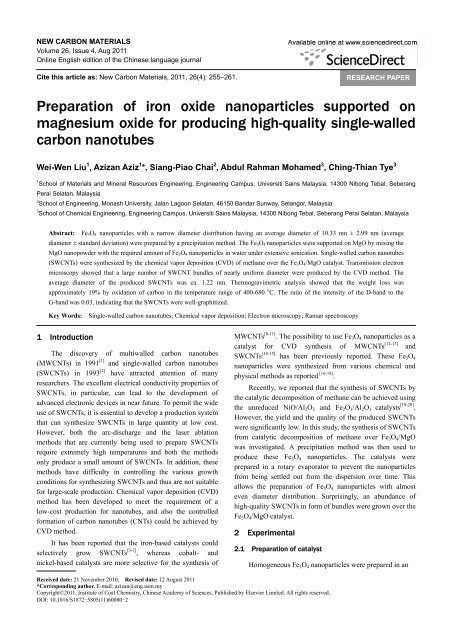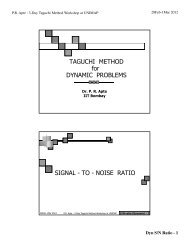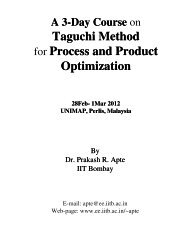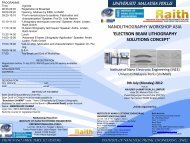Preparation of iron oxide nanoparticles supported ... - ScienceDirect
Preparation of iron oxide nanoparticles supported ... - ScienceDirect
Preparation of iron oxide nanoparticles supported ... - ScienceDirect
Create successful ePaper yourself
Turn your PDF publications into a flip-book with our unique Google optimized e-Paper software.
NEW CARBON MATERIALS<br />
Volume 26, Issue 4, Aug 2011<br />
Online English edition <strong>of</strong> the Chinese language journal<br />
Cite this article as: New Carbon Materials, 2011, 26(4): 255–261.<br />
RESEARCH PAPER<br />
<strong>Preparation</strong> <strong>of</strong> <strong>iron</strong> <strong>oxide</strong> <strong>nanoparticles</strong> <strong>supported</strong> on<br />
magnesium <strong>oxide</strong> for producing high-quality single-walled<br />
carbon nanotubes<br />
Wei-Wen Liu 1 , Azizan Aziz 1 *, Siang-Piao Chai 2 , Abdul Rahman Mohamed 3 , Ching-Thian Tye 3<br />
1<br />
School <strong>of</strong> Materials and Mineral Resources Engineering, Engineering Campus, Universiti Sains Malaysia, 14300 Nibong Tebal, Seberang<br />
Perai Selatan, Malaysia<br />
2<br />
School <strong>of</strong> Engineering, Monash University, Jalan Lagoon Selatan, 46150 Bandar Sunway, Selangor, Malaysia<br />
3<br />
School <strong>of</strong> Chemical Engineering, Engineering Campus, Universiti Sains Malaysia, 14300 Nibong Tebal, Seberang Perai Selatan, Malaysia<br />
Abstract: Fe 3 O 4 <strong>nanoparticles</strong> with a narrow diameter distribution having an average diameter <strong>of</strong> 10.33 nm ± 2.99 nm (average<br />
diameter ± standard deviation) were prepared by a precipitation method. The Fe 3 O 4 <strong>nanoparticles</strong> were <strong>supported</strong> on MgO by mixing the<br />
MgO nanopowder with the required amount <strong>of</strong> Fe 3 O 4 <strong>nanoparticles</strong> in water under extensive sonication. Single-walled carbon nanotubes<br />
(SWCNTs) were synthesized by the chemical vapor deposition (CVD) <strong>of</strong> methane over the Fe 3 O 4 /MgO catalyst. Transmission electron<br />
microscopy showed that a large number <strong>of</strong> SWCNT bundles <strong>of</strong> nearly uniform diameter were produced by the CVD method. The<br />
average diameter <strong>of</strong> the produced SWCNTs was ca. 1.22 nm. Thermogravimetric analysis showed that the weight loss was<br />
approximately 19% by oxidation <strong>of</strong> carbon in the temperature range <strong>of</strong> 400-680 o C. The ratio <strong>of</strong> the intensity <strong>of</strong> the D-band to the<br />
G-band was 0.03, indicating that the SWCNTs were well-graphitized.<br />
Key Words: Single-walled carbon nanotubes; Chemical vapor deposition; Electron microscopy; Raman spectroscopy<br />
1 Introduction<br />
The discovery <strong>of</strong> multiwalled carbon nanotubes<br />
(MWCNTs) in 1991 [1] and single-walled carbon nanotubes<br />
(SWCNTs) in 1993 [2] have attracted attention <strong>of</strong> many<br />
researchers. The excellent electrical conductivity properties <strong>of</strong><br />
SWCNTs, in particular, can lead to the development <strong>of</strong><br />
advanced electronic devices in near future. To permit the wide<br />
use <strong>of</strong> SWCNTs, it is essential to develop a production system<br />
that can synthesize SWCNTs in large quantity at low cost.<br />
However, both the arc-discharge and the laser ablation<br />
methods that are currently being used to prepare SWCNTs<br />
require extremely high temperatures and both the methods<br />
only produce a small amount <strong>of</strong> SWCNTs. In addition, these<br />
methods have difficulty in controlling the various growth<br />
conditions for synthesizing SWCNTs and thus are not suitable<br />
for large-scale production. Chemical vapor deposition (CVD)<br />
method has been developed to meet the requirement <strong>of</strong> a<br />
low-cost production for nanotubes, and also the controlled<br />
formation <strong>of</strong> carbon nanotubes (CNTs) could be achieved by<br />
CVD method.<br />
It has been reported that the <strong>iron</strong>-based catalysts could<br />
selectively grow SWCNTs [3-7] , whereas cobalt- and<br />
nickel-based catalysts are more selective for the synthesis <strong>of</strong><br />
MWCNTs [8-11] . The possibility to use Fe 3 O 4 <strong>nanoparticles</strong> as a<br />
catalyst for CVD synthesis <strong>of</strong> MWCNTs [12-13] and<br />
SWCNTs [14-15] has been previously reported. These Fe 3 O 4<br />
<strong>nanoparticles</strong> were synthesized from various chemical and<br />
physical methods as reported [16-18] .<br />
Recently, we reported that the synthesis <strong>of</strong> SWCNTs by<br />
the catalytic decomposition <strong>of</strong> methane can be achieved using<br />
the unreduced NiO/Al 2 O 3 and Fe 2 O 3 /Al 2 O 3 catalysts [19-20] .<br />
However, the yield and the quality <strong>of</strong> the produced SWCNTs<br />
were significantly low. In this study, the synthesis <strong>of</strong> SWCNTs<br />
from catalytic decomposition <strong>of</strong> methane over Fe 3 O 4 /MgO<br />
was investigated. A precipitation method was then used to<br />
produce these Fe 3 O 4 <strong>nanoparticles</strong>. The catalysts were<br />
prepared in a rotary evaporator to prevent the <strong>nanoparticles</strong><br />
from being settled out from the dispersion over time. This<br />
allows the preparation <strong>of</strong> Fe 3 O 4 <strong>nanoparticles</strong> with almost<br />
even diameter distribution. Surprisingly, an abundance <strong>of</strong><br />
high-quality SWCNTs in form <strong>of</strong> bundles were grown over the<br />
Fe 3 O 4 /MgO catalyst.<br />
2 Experimental<br />
2.1 <strong>Preparation</strong> <strong>of</strong> catalyst<br />
Homogeneous Fe 3 O 4 <strong>nanoparticles</strong> were prepared in an<br />
Received date: 21 November 2010; Revised date: 12 August 2011<br />
*Corresponding author. E-mail: azizan@eng.usm.my<br />
Copyright©2011, Institute <strong>of</strong> Coal Chemistry, Chinese Academy <strong>of</strong> Sciences. Published by Elsevier Limited. All rights reserved.<br />
DOI: 10.1016/S1872-5805(11)60080-2
Wei-Wen Liu et al. / New Carbon Materials, 2011, 26(4): 255–261<br />
centrifugation at 12 000 r/min. After repeating this procedure<br />
three times, 500 mL <strong>of</strong> 0.01 mol/L HCl solution was added<br />
to the precipitate, and the solution was stirred to neutralize the<br />
anionic charges on the <strong>nanoparticles</strong>. A sample was removed<br />
and then dried in an oven. The weight <strong>of</strong> the Fe 3 O 4<br />
<strong>nanoparticles</strong> was then used to calculate the amount <strong>of</strong> the<br />
MgO needed for preparing the catalyst with the desired<br />
composition. The mole ratio for Fe 3 O 4 to MgO was set at 1:9.<br />
Catalysts were prepared by dispersing the MgO nanopowder<br />
in water with the required volume <strong>of</strong> Fe 3 O 4 <strong>nanoparticles</strong>. The<br />
solution was then sonicated for 10 min and the water was<br />
removed using rotary evaporator. The dried catalyst was<br />
ground with a mortar and pestle to break up any agglomerates<br />
to produce very fine powders.<br />
2.2 CNT synthesis<br />
The synthesis <strong>of</strong> SWCNTs was carried out under<br />
atmospheric pressure in a quartz tube that was placed<br />
vertically in a stainless steel housing. To synthesize the<br />
SWCNTs, 0.2 g <strong>of</strong> catalyst were added to the middle <strong>of</strong> the<br />
reactor. The reactor was then heated in a tubular furnace to<br />
900 o C in flowing N 2 (99.999% purity, supplied by Sitt Tatt<br />
Industrial Gases Sdn. Bhd.) at a flow rate <strong>of</strong> 40 mL/min.<br />
Subsequently, high-purity methane (99.999% purity, supplied<br />
by Malaysian Oxygen Bhd.) was mixed with N 2 at a ratio <strong>of</strong><br />
volume 1:1 before introducing into the quartz reactor. The<br />
reaction was stopped after 30 min. The nanoparticle inside the<br />
furnace was then cooled to room temperature under nitrogen flow.<br />
2.3 Characterization<br />
Fig.1 (a) Histogram showing the diameter distribution <strong>of</strong> Fe 3 O 4<br />
<strong>nanoparticles</strong>. (b) TEM image <strong>of</strong> Fe 3 O 4 <strong>nanoparticles</strong>. (c) HRTEM<br />
image <strong>of</strong> Fe 3 O 4 <strong>nanoparticles</strong>.<br />
aqueous solution as shown in equation (1). The molar ratio <strong>of</strong><br />
Fe(II) to Fe(III) was set at 0.5, and the pH was in a range <strong>of</strong><br />
11-12.<br />
FeCl 2 + 2FeCl 3 + 8NaOH → Fe 3 O 4 + 4H 2 O + 8NaCl , (1)<br />
The aqueous solution was prepared by dissolving 4 mL<br />
<strong>of</strong> a 0.2 mol/L HCl solution, 0.69 g <strong>of</strong> FeCl 3 , and 0.25 g <strong>of</strong><br />
FeCl 2 in 25 mL <strong>of</strong> purified, deoxygenated water. The water<br />
has been previously degassed by bubbling N 2 gas through it<br />
for 30 min while stirring gently. Subsequently, 250 mL <strong>of</strong> 1.2<br />
mol/L NaOH solution was quickly added under vigorous<br />
stirring, instantly generating a black precipitate. The resulting<br />
black precipitate was isolated by centrifugation at 12 000<br />
r/min, and the supernatant was removed from the precipitate<br />
by decantation. Purified, deoxygenated water was added to the<br />
precipitate, and the solution was again decanted after<br />
The prepared Fe 3 O 4 <strong>nanoparticles</strong> and the Fe 3 O 4 /MgO<br />
catalysts were characterized using transmission electron<br />
microscope (TEM) (Philips CM12) and high-resolution TEM<br />
(HRTEM) (Philips FEI TECNAI 20). Energy-dispersive X-ray<br />
(EDX) spectra were also collected using the Philips FEI<br />
TECNAI 20. The structure and morphology <strong>of</strong> the synthesized<br />
CNTs were characterized using scanning electron microscope<br />
(SEM) (Supra 35VP-24-58) and TEM. Raman measurements<br />
were performed on the carbon samples using Raman<br />
spectroscopy (inVia Renishaw) at a wavelength <strong>of</strong> 633 nm<br />
with He-Ne laser excitation. X-ray diffraction (XRD) patterns<br />
<strong>of</strong> the fresh catalysts were characterized by Bruker AXS D8<br />
Advance diffractometer using CuKα radiation and a graphite<br />
secondary beam monochromator. The intensity was measured<br />
by step scanning in a 2θ range <strong>of</strong> 10-90 o with 0.034 o steps and<br />
a measuring time <strong>of</strong> 2 s per point. The amount <strong>of</strong> deposited<br />
carbon was characterized using thermogravimetric analysis<br />
(TGA) (TA Instrument SDTQ600). The samples were heated<br />
in flowing air (100 mL/min) from 35 to 900 o C at a heating<br />
rate <strong>of</strong> 10 o C/min.<br />
3 Results and discussion<br />
3.1 Synthesis <strong>of</strong> Fe3O4 <strong>nanoparticles</strong><br />
Fig.1a shows the TEM image <strong>of</strong> the Fe 3 O 4 <strong>nanoparticles</strong>,
Wei-Wen Liu et al. / New Carbon Materials, 2011, 26(4): 255–261<br />
Fig.2 (a) Low-magnified and (b) high-magnified TEM images <strong>of</strong> Fe 3 O 4 <strong>nanoparticles</strong> <strong>supported</strong> on MgO. (c) EDX analysis <strong>of</strong> the Fe 3 O 4 /MgO<br />
catalyst. (d) HRTEM image <strong>of</strong> the Fe 3 O 4 /MgO catalyst<br />
which appeared to be nearly spherical shape. Approximately,<br />
300 Fe 3 O 4 <strong>nanoparticles</strong> were measured from their TEM<br />
images and the histogram was drawn as shown in Fig.1b. The<br />
average diameter <strong>of</strong> the Fe 3 O 4 <strong>nanoparticles</strong> was 10.33 nm<br />
with a standard deviation <strong>of</strong> 2.99 nm. Fig.1c shows the<br />
high-resolution TEM (HRTEM) image <strong>of</strong> a Fe 3 O 4 nanoparticle.<br />
The distance between two lattice planes <strong>of</strong> the crystallite was<br />
0.25 nm, which is identical to the d-spacing <strong>of</strong> Fe 3 O 4 from the<br />
standard diffraction <strong>of</strong> Fe 3 O 4 (01-075-0449).<br />
3.2 <strong>Preparation</strong> <strong>of</strong> Fe3O4 <strong>nanoparticles</strong> <strong>supported</strong> on<br />
MgO<br />
Fig.2a shows that smaller particles (black color) were<br />
distributed over the larger particles (grey color). The element<br />
analysis <strong>of</strong> the small particles and the large particles were<br />
performed using EDX on the marked spots as shown in Fig.<br />
2b. The EDX shows the presence <strong>of</strong> Fe, Mg, and O (Fig.2c).<br />
From the HRTEM image (Fig.2d), the measured distance<br />
between two lattice planes <strong>of</strong> the crystallite was 0.25 nm,<br />
which is corresponding to Fe 3 O 4 (01-075-0449). It can be<br />
speculated from the EDX that the spot marked with A (Fig. 2d)<br />
was mainly MgO that demonstrated a strong interaction with<br />
Fe 3 O 4 due to the high-surface basicity as compared with the<br />
Fe 3 O 4 <strong>nanoparticles</strong> [21] . These interactions can be described in<br />
terms <strong>of</strong> Lewis acid/base interactions between the metal <strong>oxide</strong><br />
supports and the metal catalyst particles [22] . With this strong<br />
interaction between the Fe 3 O 4 <strong>nanoparticles</strong> and the MgO, the<br />
mobility <strong>of</strong> Fe 3 O 4 <strong>nanoparticles</strong> on MgO surface was limited<br />
and the agglomeration <strong>of</strong> these <strong>nanoparticles</strong> was reduced [23] .<br />
This was favorable to maintain the size distribution <strong>of</strong> the<br />
Fe 3 O 4 <strong>nanoparticles</strong> for the synthesis <strong>of</strong> SWCNTs.<br />
Fig.3 shows the powder XRD patterns <strong>of</strong> the freshly<br />
prepared Fe 3 O 4 <strong>nanoparticles</strong> and the Fe 3 O 4 /MgO catalyst.<br />
The representative peaks for Fe 3 O 4 and MgO were denoted in<br />
the XRD spectra. In Fig.3a, several sharp peaks,<br />
corresponding to the standard diffraction <strong>of</strong> Fe 3 O 4<br />
(01-075-0449), were noted, indicating that the Fe 3 O 4 sample is<br />
crystalline. Standard diffraction <strong>of</strong> MgO (00-045-0946) and<br />
Mg(OH) 2 (00-001-1169) were labeled in blue and green,<br />
respectively, in Fig. 3b. The formation <strong>of</strong> Mg(OH) 2 phases<br />
was due to the high moisture content <strong>of</strong> the catalyst because <strong>of</strong><br />
the short drying time (20 min) by the rotary evaporator at 80<br />
o C. As shown in Fig. 3b, the intensity <strong>of</strong> the Fe 3 O 4 peaks<br />
remained the same after mixing with the MgO support.<br />
3.3 Synthesis <strong>of</strong> CNTs<br />
Fig.4 shows the SEM images <strong>of</strong> the as-prepared CNTs.<br />
CNTs were observed on the surface <strong>of</strong> the catalyst (Fig. 4a).<br />
At a closer observation, these CNTs were formed abundantly<br />
all over the catalyst surface (Fig. 4b). The SEM discloses that<br />
well-formed CNTs were produced by the Fe 3 O 4 /MgO catalyst.<br />
Fig.5a shows the morphology <strong>of</strong> the CNTs generated at<br />
900 o C from methane decomposition over the Fe 3 O 4 /MgO<br />
catalyst. It was observed that the carbon deposits appeared in<br />
the form <strong>of</strong> SWCNT bundles with the bundle diameters<br />
ranging from 10 to 20 nm. The bundles comprised more than<br />
10 SWCNTs with individual nanotube diameters in the range <strong>of</strong>
Wei-Wen Liu et al. / New Carbon Materials, 2011, 26(4): 255–261<br />
Fig.3 XRD patterns <strong>of</strong> (a) Fe 3 O 4 <strong>nanoparticles</strong> (b) the Fe 3 O 4 /MgO catalyst, (1,1,1): 01-075-0449(A)-Magnetite-Fe 3 O 4 ; and (b) the<br />
Fe 3 O 4 /MgO catalyst, (1,1,1): 00-045-0946 (*)-Periclase, syn-MgO, (1,1,1): 00-001-1169 (D)-Brucite-Mg(OH) 2<br />
Fig.4 (a) Low-magnified and (b) high-magnified SEM images <strong>of</strong> the Fe 3 O 4 /MgO catalyst after methane decomposition<br />
Fig.5 (a) TEM image <strong>of</strong> SWCNT bundles. (b) Diameter distributions <strong>of</strong> the SWCNTs<br />
0.7-1.9 nm. It was found that occasionally SWCNTs appeared<br />
in an isolated form. However, they were most <strong>of</strong>ten packed<br />
together to form bundles due to the van der Waals<br />
interaction [2] . The histogram <strong>of</strong> the nanotube diameters<br />
measured from the TEM images are shown in Fig.5b. The<br />
diameters <strong>of</strong> the CNTs were in a range <strong>of</strong> 0.90-2.10 nm. The<br />
average diameter was 1.22 nm with a standard deviation <strong>of</strong><br />
0.19 nm.<br />
Raman analysis was performed to verify the presence <strong>of</strong><br />
SWCNTs in the carbon samples. The resulting spectrum is<br />
shown in Fig.6. There were two characteristic peaks found in<br />
the Raman spectrum at 1 350 cm -1 and 1 595 cm -1 ,<br />
corresponding to the D- and G-bands, respectively. While the<br />
G-band is associated with the high degree <strong>of</strong> order in<br />
sp 2 -bonded carbon materials, the D-band is associated with<br />
disorder [24] . A common measure <strong>of</strong> the quality <strong>of</strong> a nanotube<br />
sample is the ratio <strong>of</strong> the intensity <strong>of</strong> the D-band to the G-band<br />
(I D /I G ) [25-26] . Pure, defect-free SWCNTs have low I D /I G ratios.<br />
In this study, the calculated I D /I G was 0.03, indicating that the<br />
well-graphitized SWCNTs were grown.<br />
The peaks at low wave number, i.e. < 350cm -1 (shown in<br />
Fig.7b), are called the radial breathing mode (RBM) [27] . The
Wei-Wen Liu et al. / New Carbon Materials, 2011, 26(4): 255–261<br />
Fig.6 (a) Raman spectrum <strong>of</strong> SWCNTs. (b) The low-frequency region <strong>of</strong> Raman spectrum for the SWCNTs<br />
3.4 Growth mechanism <strong>of</strong> SWCNTs<br />
Fig.7 Thermal analysis <strong>of</strong> carbon sample<br />
presence <strong>of</strong> RBM peaks is evidence that the sample contained<br />
SWCNTs. The frequency <strong>of</strong> the RBM is inversely<br />
proportional to the diameter <strong>of</strong> the nanotube from which it<br />
arises. It has been found empirically that the diameter <strong>of</strong> the<br />
tube (d t /nm) can relate to the frequency <strong>of</strong> RBM (ωRBM) by<br />
ωRBM = A/dt + B, where A = 234 cm -1 , B = 10 cm -1 , and d t =<br />
diameter <strong>of</strong> SWCNTs in nanometer [28] . The results showed<br />
that the calculated diameters <strong>of</strong> SWCNTs were in a range <strong>of</strong><br />
0.96-2.21 nm, and it is in good agreement with the diameters<br />
measured from the TEM images. It is important to note that a<br />
single significant peak with a high intensity at Raman shift<br />
190 cm -1 was observed. This peak implies that most <strong>of</strong> the<br />
produced SWCNTs were almost uniform in a diameter, i.e. ca.<br />
1.30 nm, and this diameter was close to the average diameter<br />
presented in the histogram (Fig.5b).<br />
TGA was used to determine the percentage yield <strong>of</strong> the<br />
carbon deposit. In Fig.7, the TGA shows the weight loss due<br />
to the oxidation <strong>of</strong> carbon at temperature range <strong>of</strong> 400-680 o C.<br />
The carbon content <strong>of</strong> the catalyst was calculated as 100 X<br />
(m 1 -m 2 )/m 1 , where m 1 and m 2 are the weights <strong>of</strong> the sample<br />
before and after the carbon oxidation, respectively. The<br />
calculated carbon content was 19%. The content <strong>of</strong> amorphous<br />
carbon was approximately 0.19%, a very low value as shown<br />
by the small bump appearing at 325 o C (Fig.7). The sample<br />
contained 0.25% moisture.<br />
The formation <strong>of</strong> SWCNTs by the Fe 3 O 4 /MgO catalyst<br />
could be attributed to the strong metal interaction between the<br />
Fe 3 O 4 <strong>nanoparticles</strong> and the MgO [22] . We believe that this<br />
strong interaction restricted the mobility <strong>of</strong> Fe 3 O 4<br />
<strong>nanoparticles</strong> during the CVD, thus preventing the extensive<br />
agglomeration <strong>of</strong> Fe 3 O 4 <strong>nanoparticles</strong> at high temperature to<br />
form larger sized clusters. The growth mechanism can be<br />
explained using the vapor-liquid-solid model [29] . At the initial<br />
stage <strong>of</strong> the catalytic reaction, methane was passed over the<br />
surface <strong>of</strong> the Fe 3 O 4 /MgO catalyst and the methane was<br />
catalytically decomposed into carbon and hydrogen. The<br />
hydrogen acted as a reducing agent in reducing the Fe 3 O 4<br />
<strong>nanoparticles</strong> to Fe. This was followed by the diffusion <strong>of</strong><br />
carbon atoms into the Fe, forming <strong>iron</strong> carbide in a cementite<br />
(Fe 3 C) form [30] . When the metal was supersaturated, carbon<br />
precipitated out <strong>of</strong> the <strong>iron</strong> carbide surface to form SWCNTs.<br />
4 Conclusion<br />
In this study, we demonstrated that Fe 3 O 4 <strong>nanoparticles</strong><br />
prepared by precipitation method were effective in<br />
synthesizing SWCNTs in a bundle form. The prepared Fe 3 O 4<br />
<strong>nanoparticles</strong> were small and nearly uniform in diameter. The<br />
quality <strong>of</strong> the SWCNTs produced by the MgO-<strong>supported</strong><br />
Fe 3 O 4 catalyst was verified by the Raman analysis. The low<br />
I D /I G ratio <strong>of</strong> 0.03 shows that the synthesized SWCNTs were<br />
well-graphitized. The single peak appearing at 190 cm -1 in the<br />
Raman spectrum indicates that SWCNTs with the diameter <strong>of</strong><br />
ca. 1.30 nm appeared in majority. TGA analysis was further<br />
carried out to determine the carbon content <strong>of</strong> the catalyst<br />
after the reaction. The weight loss <strong>of</strong> 19% was observed, and<br />
the catalyst sample contained a very small amount <strong>of</strong><br />
amorphous carbon as revealed by the TGA.<br />
Acknowledgments<br />
We gratefully acknowledge the financial support<br />
provided by the Universiti Sains Malaysia under Fundamental<br />
Research Grant Scheme (FRGS) (Project: A/C No. 6071002),<br />
Research University Grant (RU) (Project: A/C No. 814004),
Wei-Wen Liu et al. / New Carbon Materials, 2011, 26(4): 255–261<br />
and Skim Penyelidikan Siswazah Universiti Penyelidikan<br />
(USM-RU-PRGS) (Project: A/C No. 8042015) and USM<br />
Fellowship.<br />
References<br />
[1] Iijima S. Helical microtubules <strong>of</strong> graphitic carbon[J].<br />
Nature,1991, 354(6348): 56-58.<br />
[2] Iijima S, Ichihashi T. Single-shell carbon nanotubes <strong>of</strong> 1-nm<br />
diameter[J].Nature, 1993, 363: 603-605.<br />
[3] Cheng H M, Li F, Su G, et al. Large-scale and low-cost synthesis<br />
<strong>of</strong> single-walled carbon nanotubes by the catalytic pyrolysis<br />
<strong>of</strong> hydrocarbons[J]. Applied Physics Letters, 1998, 72(25):<br />
3282-3284.<br />
[4] Li Y, Kim W, Zhang Y, et al. Growth <strong>of</strong> single-walled carbon<br />
nanotubes from discrete catalytic <strong>nanoparticles</strong> <strong>of</strong> various<br />
sizes[J]. The Journal <strong>of</strong> Physical Chemistry B, 2001, 105 (46):<br />
11424-11431.<br />
[5] Cheung C L, Kurtz A, Park H, et al. Diameter-controlled<br />
synthesis <strong>of</strong> carbon nanotubes[J]. The Journal <strong>of</strong> Physical<br />
Chemistry B, 2002, 106 (10): 2429-2433.<br />
[6] Nikolaev P, Bronikowski M J, Bradley R K, et al. Gas-phase<br />
catalytic growth <strong>of</strong> single-walled carbon nanotubes from carbon<br />
mon<strong>oxide</strong>[J]. Chemical Physics Letters, 1999, 313 (1-2): 91-97.<br />
[7] Zhu S, Su C H, Cochrane J C, et al. Growth orientation <strong>of</strong><br />
carbon nanotubes by thermal chemical vapor deposition[J].<br />
Journal <strong>of</strong> Crystal Growth, 2002, 234 (2-3): 584-588.<br />
[8] Ivanov V, Nagy J B, Lambin P, et al. The study <strong>of</strong> carbon<br />
nanotubules produced by catalytic method[J]. Chemical Physics<br />
Letters, 1994, 223 (4): 329-335.<br />
[9] Hernadi K, Fonseca A, Nagy J B, et al. Catalytic synthesis <strong>of</strong><br />
carbon nanotubes using zeolite support[J]. Zeolites, 1996, 17<br />
(5-6): 416-423.<br />
[10] Ago H, Komatsu T, Ohshima S, et al. Dispersion <strong>of</strong> metal<br />
<strong>nanoparticles</strong> for aligned carbon nanotube arrays[J]. Applied<br />
Physics Letters, 2000, 77 (1): 79-81.<br />
[11] Satishkumar B C, Govindaraj A, Sen R, et al. Single-walled<br />
nanotubes by the pyrolysis <strong>of</strong> acetylene-organometallic<br />
mixtures[J]. Chemical Physics Letters, 1998, 293(1-2): 47-52.<br />
[12] Li W Z, Xie S S, Qian L X, et al. large-scale synthesis <strong>of</strong><br />
aligned carbon nanotubes[J]. Science, 1996, 274(5293):<br />
1701-1703.<br />
[13] Xie S S, Chang B H, Li W Z, et al. Synthesis and<br />
characterization <strong>of</strong> aligned carbon nanotube arrays[J].<br />
Advanced Materials, 1999, 11(13): 1135-1138.<br />
[14] Fu Q, Reed L, Liu J, et al. Characterization <strong>of</strong> single-walled<br />
carbon nanotubes synthesized using <strong>iron</strong> and cobalt<br />
<strong>nanoparticles</strong> derived from self-assembled diblock copolymer<br />
micelles[J]. Applied Organometallic Chemistry, 2010, 24(8):<br />
569-572.<br />
[15] Zhang Y, Li Y, Kim W, et al. Imaging as-grown single-walled<br />
carbon nanotubes originated from isolated catalytic<br />
<strong>nanoparticles</strong>[J]. Applied Physics A: Materials Science and<br />
Processing, 2002, 74(3): 325-328.<br />
[16] Ahmadi T S, Wang Z L, Green T C, et al. Shape-controlled<br />
synthesis <strong>of</strong> colloidal platinum <strong>nanoparticles</strong>[J]. Science, 1996,<br />
272(5270): 1924-1925.<br />
[17] Andres R P, Bielefeld J D, Henderson J I, et al. Self-assembly <strong>of</strong><br />
a two-dimensional superlattice <strong>of</strong> molecularly linked metal<br />
clusters[J]. Science, 1996, 273(5282): 1690-1693.<br />
[18] Zach M P, Penner R M. Nanocrystalline nickel <strong>nanoparticles</strong>[J].<br />
Advanced Materials, 2000, 12(12): 878-883.<br />
[19] Chai S P, Zein S H S, Mohamed A R. Moderate temperature<br />
synthesis <strong>of</strong> single-walled carbon nanotubes on alumina<br />
<strong>supported</strong> nickel <strong>oxide</strong> catalyst[J]. Materials Letters, 2007,<br />
61(16): 3519-3521.<br />
[20] Tan S M, Chai S P, Liu W W, et al. Effects <strong>of</strong> FeOx, CoOx, and<br />
NiO catalysts and calcination temperatures on the synthesis <strong>of</strong><br />
single-walled carbon nanotubes through chemical vapor<br />
deposition <strong>of</strong> methane[J]. Journal <strong>of</strong> Alloys and Compounds,<br />
2009, 477(1-2): 785-788.<br />
[21] Sun C, Berg J C. A review <strong>of</strong> the different techniques for solid<br />
surface acid-base characterization[J]. Advances in Colloid and<br />
Interface Science, 2003, 105(1-3): 151-175.<br />
[22] Dupuis A C. The catalyst in the CCVD <strong>of</strong> carbon nanotubes-a<br />
review[J]. Progress in Materials Science, 2005, 50 (8): 929-961.<br />
[23] Moisala A, Nasibulin A G, Kauppinen E I. The role <strong>of</strong> metal<br />
<strong>nanoparticles</strong> in the catalytic production <strong>of</strong> single-walled<br />
carbon nanotubes-A review[J]. Journal <strong>of</strong> Physics Condensed<br />
Matter, 2003, 15(42).<br />
[24] Pimenta M A, Jorio A, Brown S D M, et al. Diameter<br />
dependence <strong>of</strong> the Raman D-band in isolated single-wall carbon<br />
nanotubes[J]. Physical Review B-Condensed Matter and<br />
Materials Physics, 2001, 64(4): 414011-414014.<br />
[25] Qian W, Liu T, Wei F, et al. Quantitative Raman characterization<br />
<strong>of</strong> the mixed samples <strong>of</strong> the single and multi-wall carbon<br />
nanotubes [J]. Carbon, 2003, 41 (9): 1851-1854.<br />
[26] Athalin H, Lefrant S. A correlated method for quantifying mixed<br />
and dispersed carbon nanotubes: Analysis <strong>of</strong> the Raman band<br />
intensities and evidence <strong>of</strong> wavenumber shift[J]. Journal <strong>of</strong><br />
Raman Spectroscopy, 2005, 36 (5): 400-408.<br />
[27] Dresselhaus M S, Dresselhaus G, Saito R, et al. Raman<br />
spectroscopy <strong>of</strong> carbon nanotubes[J]. Physics Reports, 2005,<br />
409 (2): 47-99.<br />
[28] Dresselhaus M S, Dresselhaus G, Jorio A, et al. Single nanotube<br />
Raman spectroscopy[J]. Accounts <strong>of</strong> Chemical Research, 2002,<br />
35 (12): 1070-1078.<br />
[29] Baker R T K, Harris P S, Thomas R B, et al. Formation <strong>of</strong><br />
filamentous carbon from <strong>iron</strong>, cobalt and chromium catalyzed<br />
decomposition <strong>of</strong> acetylene[J]. Journal <strong>of</strong> Catalysis, 1973, 30<br />
(1): 86-95.








